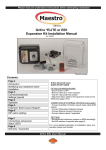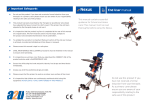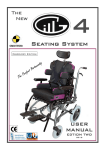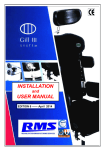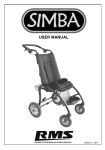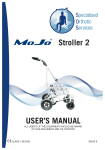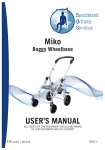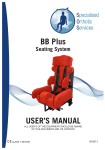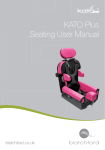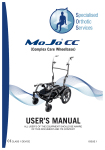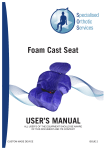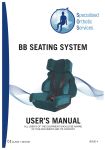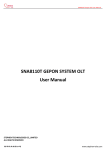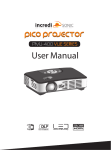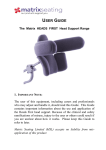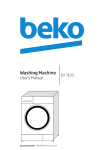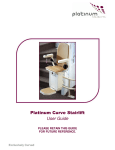Download Gill 2 on Neo
Transcript
2 Seating System Installation and User Manual For use with the NEO Wheelbase by Southwest Seating (July 2014 Edition) Seating Systems Manufactured By THOMPSON HOUSE Unit 10, Styles Close, Sittingbourne, Kent, ME10 3BF Tel: 01795 477280 Fax: 01795 229692 E-mail: [email protected] Web: www.ineedawheelchair.co.uk GENERAL INFORMATION RECORD Your GILL 2 Seating System Serial Number is: ………………......……… Wheelchair Model and Serial Number .................................................... Date of Supply: ……………………… Supplied to: ………………………………………………………………. ………………………………………………………………. .……………………………………………………………… Seating Systems NOTES 19 WARRANTY STATEMENT Every effort is made by RMS Ltd., to ensure that your GILL 2 Seating System is manufactured to the highest standards and supplied to the specifications as detailed on the initial prescription / order. The supply of our quality products is backed by the company’s ISO 9001 –2008 Quality Management System and CE Marking declaration. The GILL 2 Seating System is supplied with a manufacturer’s warranty covering faulty materials or workmanship, for a period of twelve months from the date of despatch from our factory. In the unlikely event of a warranty claim being necessary, the failed part must be returned to the manufacturer, or the manufacturer’s approved repairer, for inspection. The failed part may then be repaired or replaced at the manufacturer’s discretion or that of their approved repairer. In the latter case, any displaced parts must be returned to the manufacturer for inspection. Any part, component or accessory, repaired or replaced during the twelve month warranty period, will continue to be covered for the balance of the warranty period only. As unusually high rates of wear on this device, or its ancillary parts, may be caused by the user’s clinical condition, the manufacturer may consider this to be beyond its control. Therefore, items such as Upholstery may only be considered for repair or replacement under the terms of the product warranty, where a failure is clearly attributed to a manufacturing or material defect. With the exception of modifications and / or alterations carried out by the manufacturer, to meet the clinical needs of the user, any attempt to change the design or modify the construction of the GILL 2 Seating System in any way, without prior written authorisation from RMS Ltd, will invalidate the product warranty and the manufacturer’s CE marking declaration. For assistance with any matters relating to the product warranty or for technical information, please contact the RMS Technical Help-line on 01795 477280. PRODUCT MAINTENANCE Contents Introduction .................................................... 4 Technical Data ................................................ 4 Safety Guidelines ............................................ 5 Transportation Information .............................. 6 Gill 2 Seat Components Plan .......................... 7 Initial Installation (NEO Range) ..................... 8-9-10 Gill 2 — NEO Range Package Installation ....... 10-11 Seat Depth Adjustment .................................... 12 Backrest Height Adjustment ............................. 13 Pelvic Support Adjustment ............................... 14 Thoracic Support Adjustment ........................... 14-15 Headrest Adjustment ........................................ 16 Upholstery and Cleaning ................................... 17 Warranty Statement ........................................... 18 Product Maintenance ......................................... 18 Product Serial Numbers ..................................... 19 For safety and security reasons, RMS Ltd recommends that all external components such as the Seat Interface, Backrest Mounting, Headrest Mounting, Pelvic Support Mountings, Thoracic Support Mountings and Pommel Mountings are checked for security at regular intervals. Inspection frequency should be increased accordingly for heavy users. Any defects should be reported to the appropriate authority, with any repairs being carried out by a suitably qualified person, using genuine original equipment replacement parts, available direct from RMS Sales. For assistance with any technical information relating to the Gill 2 Seating System, please contact our Technical Helpline on 01795 477280. The Gill 2 Seating System is the result of experienced, thoughtful design and rigorous in-house testing, field trials and frontal impact testing over 12 months. Many adjustable features have been built into the Gill 2, enabling it to become an extremely versatile seating system, available in four sizes. RMS Ltd, reserves the right to change without notice, the design, methods of manufacture, or raw materials used in the construction of the Gill 2 Seating System, where it considers such changes will serve to improve the product quality, or become necessary to meet any changes in device legislation. Should the reader have any concerns regarding the installation, set-up, adjustments, or use of the Gill 2 Seating System, please contact the RMS Ltd Technical Help-line on 01795 477280. 18 3 INTRODUCTION UPHOLSTERY The Gill 2 Seating System has been developed to be interfaced with the Invacare Action 3 range of wheelchairs and the NEO tilting wheelbase from the Southwest Seating Company. This publication is intended to cover the installation of the Gill 2 Seating System onto a NEO Wheelbase only, as separate manuals are supplied with the Gill 2 when interfacing with the Invacare Action 3 range. The Standard Gill 2 consists of: One piece modular seating system including interface. Growth adjustment in Seat depth, Backrest height, Hip and Thoracic widths. Padded Lap Belt. Swing-away, width adjustable, Thoracic Supports. Ramped Seat Cushion. RMS Type “D” Headrest. Machine Washable Covers. Full length, width adjustable, Pelvic Supports. Further compatible accessories are available from the RMS Product and Accessory Catalogue. Technical Information Gill 2 Seating System Size Guide Size 1 Gill2-1-01-00 Size 2 Gill2-2-01-00 Size 3 Gill2-3-01-00 Size 4 Gill2-4-01-00 Pelvic Width Min / Max 200mm / 275mm 250mm / 325mm 315mm / 375mm 365mm / 425mm Seat Depth Min / Max 225mm / 300mm 300mm / 375mm 360mm / 435mm 430mm / 505mm Backrest Height Min / Max 355mm / 430mm 390mm / 465mm 450mm / 525mm 500mm / 575mm H x L 78mm x 113mm 88mm x 138mm 98mm x 168mm 108mm x 188mm H x L 75mm x 275mm 100mm x 325mm 100mm x 400mm 100mm x 475mm Thoracic Pad size Pelvic Pad size Seat Ramp Length 145mm 170mm 180mm 190mm Weight capacity for Transportation 50Kg 50Kg 50Kg 50Kg Max Weight capacity 80Kg 80Kg 80Kg 80Kg Seat Unit Weight 6Kg 7.8Kg 9.3Kg 10.9Kg NOT Compatible with the Neo Wheelbase (Width Adjustable) (Width Adjustable) (Width Adjustable) Neo Wheelbase Neo Wheelbase Neo Wheelbase Recommended Surrogate Wheelbase 4 Unless otherwise requested, your Gill 2 Seating System will be finished in twotone upholstery. The main base colour material, will be of black 100% Polyester, 3mm “Spacer” fabric, complemented by colour co-ordinated edging panels of 100% Polyester Agua Libra fabric. All upholstery items are easily removable, for cleaning or machine washing. Both fabrics are:Flame Retardant to BS5852 Crib 5 and meet or exceed BSEN1021. Anti-Bacterial / Anti Fungal i.e. will not support microbial or fungal growth including Salmonella, E Coli and MRSA. Waterproof — Water or oil Breathable — Moisture vapour permeable. General Fabric Care Use of a vacuum cleaner or soft brush, to remove dust and small solid particles, together with frequent wiping with a damp cloth, will to help to maintain the appearance of the fabrics. Spillages should always be removed as quickly as possible with an absorbent dry cloth. Minor Soiling can normally be removed with a clean damp cloth. Water Based Stains can be cleaned using mild liquid detergent with warm water. Cold water should be use for stains produced by bodily fluids, then rinsed Thoroughly. Followed by drying with a clean absorbent cloth. Light Steam Cleaning can be carried out in situ, ensure all areas are completely dry before reuse. Machine Washing with care @ 40°. Covers must NOT be turned inside-out and any zips should be fully closed. Remove from machine as soon as the wash cycle has finished. DO NOT DRY CLEAN Line Dry ideally the upholstery should be “Line Dried” do NOT Tumble Dry. See Symbols below. NOTES: All soap residue must be thoroughly rinsed out of all fabrics, as it can attract further stains. All stains caused by bodily fluids, should be removed immediately. As with all fabrics, stains that are left in situ for over 24 hours will have set and will become increasingly difficult to remove. Always pre-test cleaners on a hidden area of fabric to test for colour-fastness and texture before proceeding with cleaning. Wash at 40° Cent. Line Dry Iron at MED Temp Do NOT Tumble Dry 17 Do NOT Bleach Do NOT Dry Clean HEADRESTS SAFETY GUIDELINES The Gill 2 Seating System, is fitted as standard, with an RMS Type D Headrest, incorporating a Ball Mount, Angle Adjustable Stem with height pre-set collar and a two screw fixing Backrest Mount. Correct positioning of the Headrest to suit individual requirements, is normally achieved by a combination of adjustments. Refer to Fig.16. Due to the various activities that a wheelchair user has to perform, RMS Ltd recommends that, prior to issuing the GILL 2 Seating System and the wheelchair into which it is to be interfaced, this manual, together with any wheelchair manufacturer’s User Guide, should be studied by all relevant persons, to ensure that all instructions, procedures and warnings are carefully observed and understood. For correct support and user comfort, it is strongly recommended that the initial installation, any adjustments and final hand-over are carried out by a suitably qualified person. The maximum occupant capacity of a complete GILL 2 Seating System for transportation purposes, when interfaced into a Wheelbase with a Seat Unit width up to 19”, is 50Kg (7.8 stones). As the installation of a GILL 2 System may raise or position the user further forward in their wheelchair, an appropriate stability test should be carried out prior to final commissioning. To accommodate any changes in user growth or postural positioning, it is recommended that the user be checked at regular intervals by a suitably qualified person, to ensure that adjustable components are correctly set to suit the user’s current requirements. Carers should ensure correct utilisation of any positioning Straps or Harnesses, as failure to do so could result in injury to the user. It is recommended that any Postural Straps or Harnesses being used, are the first items to be secured when the user enters the seat and the last items to be released before exiting. Worn or damaged upholstery can lead to hygiene contamination, cause injury to the user and, in some cases, fail to support the user correctly. Regular inspections of all upholstery should be made and any defects should be reported to the relevant authority for rectification as soon as possible. Ancillary devices, such as the Headrest, positioning Straps and Harnesses, Kneeblock or Pommel should be checked for security and positioning on a daily basis. The wheelchair parking brakes should always be applied before attempting to transfer the occupant, removing or refitting the GILL 2 System or making any adjustments. Never hang heavy objects on the GILL 2 Seating System or any part of the wheelchair, as this could seriously affect the overall wheelchair stability. Any reference to Left or Right in this manual, will refer to the Left or Right side when sitting forward facing in the Seat Unit. Tools Required: 3, 4 and 5mm Hexagon Keys. 13mm Spanner. To adjust Headrest Position:The Ball Mount built into the Headrest, enables the Headrest to swivel around the ball. The three screws should be slackened to allow correct positioning and always retightened evenly to maintain the Headrest position. The Angle Adjustable Stem has two pivot points, both of which should be slackened to enable the Headrest to be moved in a forward or rearward direction. Fully tighten both M8 nuts sufficient to prevent any movement. The overall height of the Headrest and Stem assembly, is locked-off by the Black Thumb Screw located on the Stem Mount attached to the Backrest. To enable the Headrest to be refitted to the same height each time after removal, the Stem is supplied with a pre-set Height Positioning Collar. This should be locked in place by it’s grub-screw, when all other Headrest positioning adjustments have been completed. The Headrest should therefore, always removed and refitted from the Receiver Mount as an assembly. Fig.16 Ball Mount RMS Type “D” Headrest Pre-set Height Positioning Collar Angle Adjustable Stem Headrest Stem Receiver Mount Thumb Screw 16 5 TRANSPORTATION The Gill 2 Seating System is the result of experienced, thoughtful design and rigorous testing over 12 months of in-house testing and frontal impact testing. THORACIC SUPPORT ADJUSTMENTS Continued Fig.14 Swing-away Lock Buttons The Gill 2 was successfully tested to ISO 16840-4 at the Transport Research Laboratory in May 2013, using the HIII 5th Percentile Test Dummy to 49Kg. However, this does not imply and is not intended to imply in any way, that the GILL 2 Seating System is suitable for transporting an occupant in a motor vehicle in any other way than with the GILL 2 Seating System being correctly interfaced with a surrogate wheelchair of a type and model which has been successfully tested in its own right, to meet the requirements of ISO 7176-19 (Wheeled mobility devices for use in Motor Vehicles). The transporting vehicle MUST be suitably equipped with wheelchair and occupant restraint systems compliant with ISO 10542. Under No Circumstances should any part of a transportation restraint system, be attached directly to the GILL 2 Seating System. ALWAYS check both backrest retaining strap buckles (Fig.5) are connected & tensioned sufficiently prior to using the GILL 2 on transportation. Whilst provision is made on the GILL 2 Backrest for attachment of an ancillary Postural Positioning Harness, which, if fitted, should still be utilised as normal during any transportation period, this positioning device should NEVER be used as the sole method of occupant restraint during transportation. The restraint systems used for the surrogate wheelbase and occupant during the above testing, are manufactured by:Unwin Safety Systems. C.N. Unwin Ltd., Unwin House, The Horseshoe, Coat Road, Martock, Somerset, TA12 6EY. Tel: 01935 827740 Fax: 01935 827760 Email: [email protected] www.unwin-safety.co.uk Part numbers:Wheelbase restraints: Front—OF03 Rear—OR02 Occupant restraints: Static 3PT These kits meet the requirements of ISO 10542, (Wheelchair Tie-downs and Occupant Restraint Systems). If the intended transporting vehicle is not already fitted with Unwin type anchorage tracks, details of these can also be obtained direct from Unwin Safety Systems Ltd NOTE: Installation and use of all restraint systems should always be strictly as per their manufacturers recommendations. 6 Tools Required: 4mm Hexagon Key Alternative Mounting Positions Fig.15 Thoracic Support Mounting Screws Alternative Mounting Positions To adjust Thoracic Pad Height:1. To raise or lower the Thoracic Supports, remove the Velcro attached Backrest Cushion from the Backrest Panel. 2. Using the 4mm Hexagon Key, remove the two M6 Hex. Head Mounting Screws Fig.14, securing the Thoracic Supports to the Backrest Panel. (NOTE: Retain screws and key washers). 3. Move Thoracic Support to the required Height, in line with the nearest mounting holes in the Backrest Panel. (NOTE: Mounting holes have 25mm centres vertically and 50mm centres laterally). 4. Whilst holding the Thoracic Support, together with the two key washers, in the required position on the front face of the Backrest Panel insert each retaining screw through the appropriate hole in the Backrest Panel and screw into the key washers, ensuring that the key washers are correctly located in the Thoracic Support Mounting Brackets. (DO NOT FULLY TIGHTEN at this stage). 5. Repeat the above for the opposite side. (then continue with operation 6) To adjust Thoracic Pad Width:NOTE: It will not be necessary to carry out operations 1—5, when adjusting the width only. 6. To obtain the required Thoracic Support width, slacken both Mounting Screws for each Support Fig.15, using the 4mm Hexagon Key. Slide the Mounting Brackets inwards or outwards, along their key washers, to the required position. Whilst holding the Pads in the upright position, fully re-tighten all screws sufficient to prevent any movement. 7. After completing any adjustments, ensure all screws are fully tightened sufficient to prevent any movement. Re-attach the Backrest Cushion via the Velcro panels. 15 GILL 2 SEAT COMPONENTS PLAN PELVIC SUPPORT ADJUSTMENTS Fig.12 Support Brackets IMPORTANT NOTE: Unless specific dimensions have been requested with the original order, the Pelvic Supports will be set to an average position and may not be fully tightened. Therefore, correct positioning and security will be necessary. The Gill 2 full-length Pelvic Supports are individually adjustable by 55mm each side. The minimum and maximum Pelvic Widths for each of the Gill 2 seat sizes are stated in the Technical Information section on page 4. RMS Type “D” Headrest with angle-adjustable Stem. Fully Upholstered Backrest Cushion with removable, machinewashable cover. Height and width adjustable, positive locking, swing-away Thoracic Supports, with removable machine- washable covers. RMS Padded, Single-pull, Pelvic Belt PB009 sizes 2 PB007 sizes 3&4 Tools Required: 10mm Spanner Fig.13 M6 Domed Nylock Nuts To adjust Pelvic Support Width:1. Slacken the two M6 Domed Nylock Nuts retaining the Pelvic Support Brackets on each side, located under the Seat Board, Fig.13, sufficient to allow the Pelvic Support to be moved inwards or outwards to the required position. 2. Re-secure Pelvic Supports by retightening the M6 domed Nylock Nuts sufficient to prevent any movement. THORACIC SUPPORT ADJUSTMENTS Width adjustable full-length Padded Pelvic Supports, with removable machine- washable covers. Fully Upholstered Ramped Seat Cushion with removable machinewashable cover. Backrest Retaining Straps with Pull-tight Buckles Interface Seat Hook Brackets, with pre-drilled alternative mounting positions. Pre-drilled Backrest Panel to enable attachment of upper Harness Straps. Hayden Clamps installed onto Seat Rails to locate Seat Hook Brackets The Thoracic Supports are of the positive locking, Swing-away style, already being successfully used on other RMS Gill Seating Systems, such as the Gill 3 Junior, Gill 3 and the Gill 4. To enable the Supports to Swing-away during user transfers, depress the green lock button located on the top of the Support Arms at the rear of the Thoracic Pads, Fig.14. The Pads will then positively lock when returned to the forward support position. IMPORTANT NOTE: Unless specific dimensions have been requested with the original order, the Thoracic Supports will be set to an average position but may not be fully tightened. Therefore, correct positioning and security will be necessary. Having slotted mounting plates and two lines of mounting holes, enables the Thoracic Supports to be width and height adjustable on the Backrest Panel. [Cont] 14 Extended Backrest Cushion to allow for use of Back Extension 7 Extended Seat Cushion allow for use of Seat Extension GILL 2 INITIAL INSTALLATION—NEO Wheelbase BACKREST HEIGHT ADJUSTMENT The Gill 2 Seating System may be supplied as a complete package, already interfaced with its NEO wheelbase, or as an individual Seat Unit, for installation by a Wheelchair Service to their own stock NEO wheelbase. NOTES: The instructions detailed on these two pages, cover installation where the Seat Unit has been supplied as an individual Seat Unit for installation by a Wheelchair Service. Gill 2 Seat Units will be supplied for NEO Width-Adjustable Wheelbases, pre-set to widths of 15, 17 and 19inches (380, 430 and 480mm), together with all necessary interfacing Clamps, Brackets and Straps. (Seat width measurements are to the outside of the seat rails) In view of the number of mounting position combinations for the Seat Hook Brackets, in relation to the Seat Unit size, positioning on the wheelbase and the seat width to which the wheelbase has been set, final positioning of the seat and interfacing bracketry my vary slightly from those described in these instructions. From the standard position, the Backrest height is adjustable upwards by up to 75mm, Fig.9. It is possible for this adjustment to be carried out with the User seated, providing their upper trunk is able to lean forward. If not, the User should exit the Seat Unit while the adjustment is carried out. Tools Required: 4mm Hexagon Key To adjust Backrest Height:1. From the top, fold the Velcro attached Backrest Cushion forwards. 2. Using the 4mm Hexagon Key, slacken the M6 Hex. Drive Screws securing the Backrest Extension Panel Fig.10. 3. Slide Backrest Height Adjustment Panel upwards to the required position and retighten the M6 Hex. Head Screws. 4. Re-attach Backrest Cushion with top edge just level with the newly positioned Adjustment Panel. NOTE: The Cushion is designed to be long enough to cover the Backrest Panel when set to maximum height. Tools Required: 13mm Spanner, 10mm Spanner and 4mm Hexagon Key. * (2 x 155mm x 8mm Stainless Steel rods are supplied with the Gill 2 Seat Unit) Position the NEO Wheelbase in a suitable work area and apply both parking brakes. For ease of working, remove both Footrests and Hangers, also both Sidearms and retain for refitting after completion of Gill 2 installation. Confirm the Gill 2 Seat width is compatible with the pre-set NEO seat rails. (i.e. the edge of the Seat Base Board should be level with the Fig. 1 outer edge of each seat rail). Using the two *155mm steel rods supplied Fig.1, open up the four front Hook Bracket Locating Clamps, sufficient to be positioned over the NEO seat rails, two required on each side Fig.2. Re-close all Clamps over the seat Fig. 2 Front Hook Bracket rails, using the two *steel rods Locating Clamp Rear Hook Bracket supplied and insert the Clamp bolts Locating Clamp from the outside and clamping nuts and washers on the inside, Fig.2 With the front Clamps positioned immediately behind the wheelbase front cross frame Fig.2, tighten clamping nuts sufficient to prevent any movement. Leave the rear Clamps loose at this stage and approximately 50mm rearwards of the Front Hook Front Cross front clamps. Bracket Frame [Cont] 8 Fig.9 Backrest Extension Panel in lower position Fig.10 Fig.11 Backrest Extension Panel M6 Hex. Drive Screws Backrest Extension Panel in raised position 13 SEAT DEPTH ADJUSTMENT From the standard retracted position, the Seat Depth can be extended forwards by up to 75mm, Fig.6. It will be necessary for the User to exit the Seat Unit for this adjustment. Tools Required: 10mm Spanner To adjust Seat Depth:1. Remove the Velcro attached Seat Cushion. 2. Slacken the M6 Domed Nylock Nuts securing the front Pelvic Support Brackets Fig.7. 3. Slide Seat Depth Adjustment Panel forwards to the required position, Fig.8 and retighten the domed Nylock Nuts Fig.7. 4. Re-attach Seat Cushion with front edge just overlapping the newly positioned Adjustment Panel. NOTE: The Seat Cushion is designed to be long enough to cover the Seat Panel when set to maximum length. Fig.6 Adjustment Panel Retracted Front Pelvic Support Bracket Fig.8 Fig.7 Adjustment Panel Extended M6 Domed Nylock Nuts 12 With the Seat Cushion removed, place the Gill 2 Seat Unit squarely in the required position on the NEO seat rails, ideally with the Gill 2 Backrest resting against and parallel in line with, the NEO Backrest frame. Initially the rear Seat Hook Brackets should be attached to the Seat Base Board, normally using the rearmost mounting holes in the Baseboard, Fig.3. ** With the hooks on the outside of the Fig. 3 seat rails pointing downwards, slide the rear Hook Brackets between the seat rails and Seat Board, to line up with the Rear Hook Bracket rearmost pair of mounting holes on each Mounting Points side, Fig3. Attach the Hook Brackets to the Seat Board using the M6x25mm countersunk hex. drive screws, plain washers and M6 domed Nylock nuts supplied. Ensure Hook Brackets are in Front Hook Bracket full contact with the seat rails when Mounting Points tightening all nuts sufficient to prevent any movement. ** Insert the front Seat Hook Brackets between the Seat Base Board and wheelbase seat rails and position against the front Locating Clamp. Move the Seat Unit if necessary, just sufficient to allow the nearest mounting holes in the Base Board to align with the holes in the Hook Bracket, (Fig.3 as an example). Attach the Hook Brackets to the Seat Board using the M6x25mm countersunk hex. drive screws, plain washers and M6 domed Nylock nuts. Ensure Hook Brackets are in full contact with the seat rails when tightening Fig. 4 Rear Hook Front Hook all nuts sufficient to prevent any Bracket Bracket movement. Slide the front Hook Bracket rear mounting Clamps forwards, to contact the front Hook Brackets and tighten clamping nuts sufficient to prevent any movement. Fig.4 shows an example of the Hook Brackets and Clamp positions. (15" (380mm) seat Front Locating width model shown). Clamp positions on all models Where the larger NEO bases may have their Backrest frame located further back on the seat rails, this may require repositioning the front Hook Brackets further forwards on the Seat Base Board. The Seat Depth Adjustment Panel will need to be slackened and moved forwards to gain access to the alternative mounting positions. Refer to Fig.6, page 12 for this feature. Locating Clamps stay in the same position as shown for all NEO models. [Cont] 9 GILL 2 — NEO Package INSTALLATION Continued GILL 2 INITIAL INSTALLATION Continued With the Seat Base now in position, Fig.5 route the Backrest Retaining Straps outwards in front of the Backrest Tubes, then around the outside of the Tubes, finally to be connected centrally by the Main Buckles as Fig.5. The Straps can be tensioned by pulling the free-end “D” Ring Straps outwards to remove any slack, Fig.5. NOTES: Ensure Backrest Alignment Brackets Fig.5 are correctly located between the Backrest Tubes before fully tightening Straps. Backrest Alignment Brackets NOTES: Ensure Backrest Alignment Brackets Fig.5 are correctly located between the Backrest Tubes before fully tightening the Straps. If dimensions such as Seat Depth, Backrest Height, Backrest Angle, Pelvic Width or Thoracic Width and Height were stated at the time of order, these will be factory set by RMS prior to despatch. Some minor adjustments may be necessary to suit any possible changes in User requirements. Please refer to the following pages for adjustments. Pull-tight Straps with “D” Rings Changing the wheelbase Backrest angle, may also require changing the position of the Seat Base Hook Brackets and/or re-tensioning of Backrest Retaining Straps. Backrest Retaining Strap Main Buckles GILL 2 — NEO Package INSTALLATION Where the Gill 2 Seat Unit is supplied, together with an appropriate size NEO wheelbase as a package, the wheelbase will have the necessary Gill 2 Seat Hook Bracket Locating Clamps, factory installed by RMS ready to accept the Seat Unit. The RIGHT side Seat Hook Brackets will be left loose on the Seat Base Board and must be removed from the Seat Unit, to allow installation onto the NEO wheelbase. Unpack the NEO wheelbase and prepare for use, as detailed in the attached NEO User Manual. Unpack the Gill 2 Seat Unit and remove the loose RIGHT side Seat Hook Brackets. Locate the Seat Unit onto the NEO wheelbase seat rails, by hooking the LEFT side Hook Brackets over the LEFT seat rail, with the front Hook Bracket located between the two Locating Clamps fitted to the seat rail immediately behind the front cross member, Fig.4. Lower the Seat Unit down onto both seat rails. Re-attach the RIGHT side Hook Brackets to their previous positions, as details on page 9 (the two paragraphs marked **), ensuring that the Hook Brackets are in full contact with the seat rails when tightening all nuts sufficient to prevent any movement. 10 With the Seat Base now in position, route the Backrest Retaining Straps outwards in front of the Backrest Tubes, then around the outside of the Tubes, finally to be connected centrally behind the Backrest Tubes by the Main Buckles as Fig.5. The Straps can then be tensioned by pulling the free-end “D” Ring Straps outwards to remove any slack, Fig.5. PELVIC BELT ATTACHMENT With the Gill 2 Seat Unit securely interfaced on to the NEO Wheelbase, the Pelvic Belt must be attached. Each “Free-end” of the Belt can be routed downwards between the Pelvic Supports and Seat Cushion and finally connected to the NEO Backrest Pivot Brackets as Fig.5a. Final adjustment of the Pelvic Belt should be carried out with the User seated, by means of the Pull Tight “D” rings located at either side of the main buckle. Fig.5a 11











